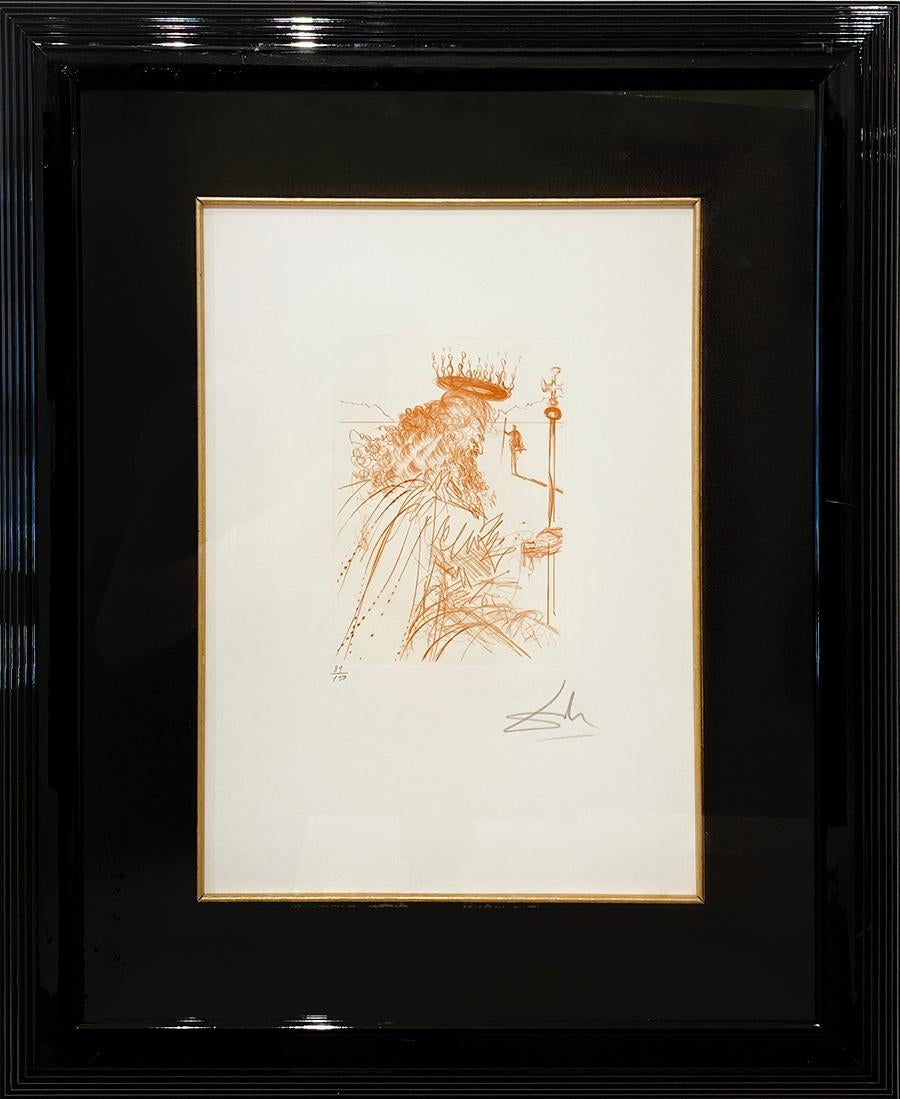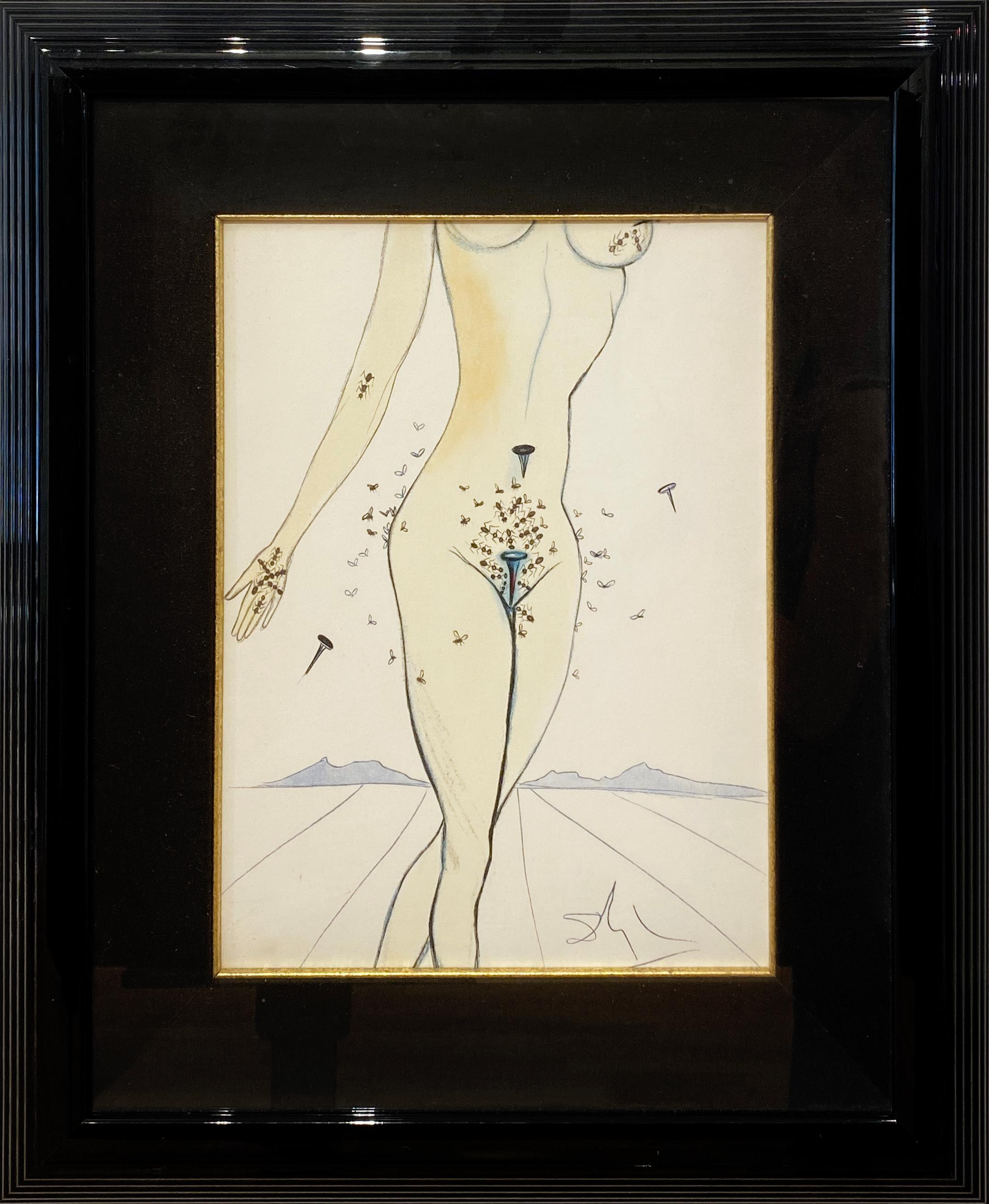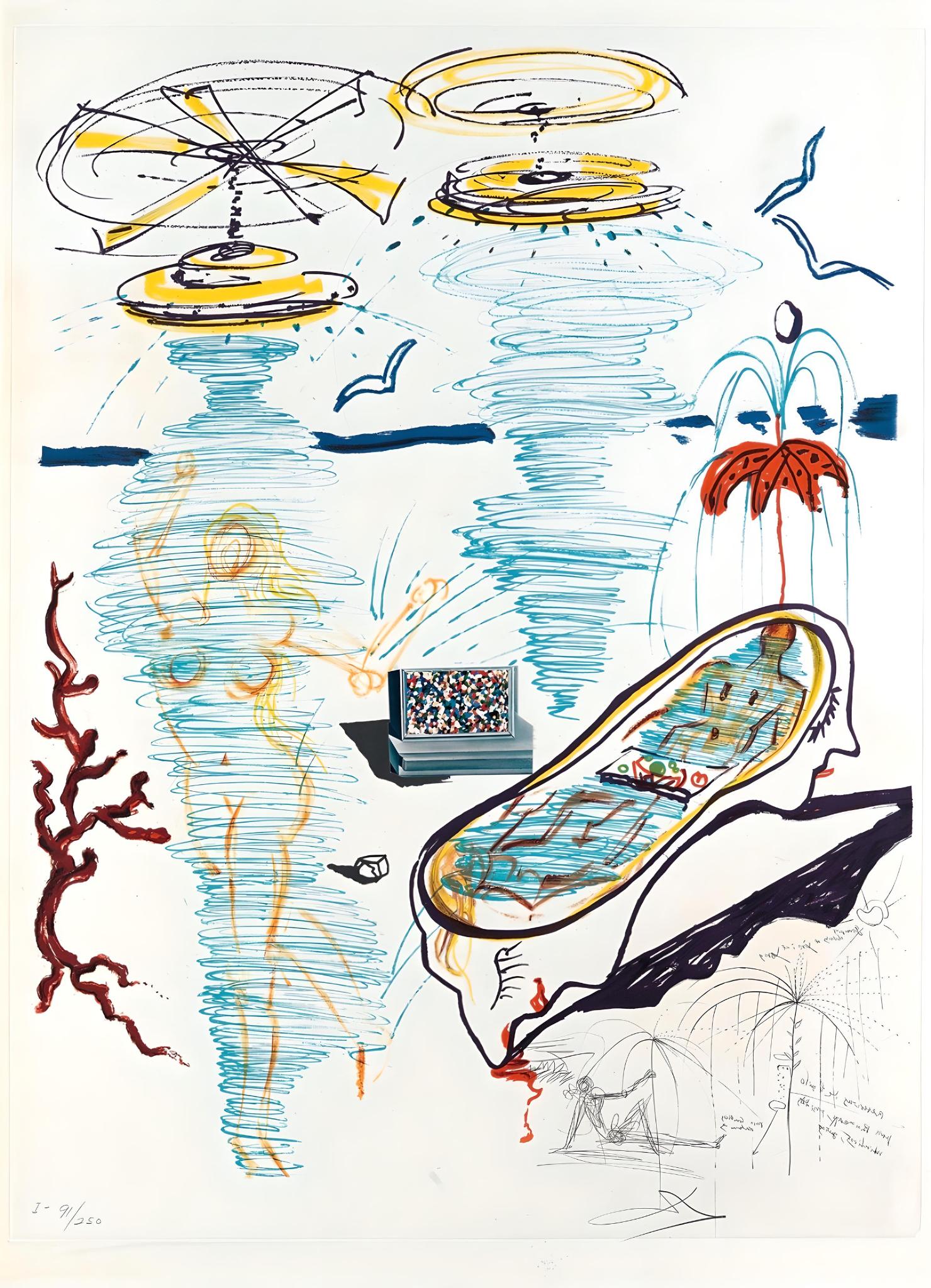Salvador DalíOysters and Nude1967
1967
About the Item
- Creator:Salvador Dalí (1904 - 1989, Spanish)
- Creation Year:1967
- Dimensions:Height: 22.5 in (57.15 cm)Width: 18.5 in (46.99 cm)Depth: 1 in (2.54 cm)
- Medium:
- Movement & Style:
- Period:
- Condition:framing sold as is.
- Gallery Location:Boston, MA
- Reference Number:1stDibs: LU23713345892
Salvador Dalí
Instantly recognizable by his waxed, upturned mustache, the flamboyant Salvador Dalí is one of modern art’s most distinctive figures. He is also one of the icons of the 20-century avant-garde Surrealist movement, whose dreamlike images, drawn from the depths of the unconscious, he deployed in paintings, sculptures, prints and fashion, as well as in film collaborations with Luis Buñuel and Alfred Hitchcock.
Dalí was born in Figueres, Catalonia, and even as a youngster, displayed the sensitivity, sharp perception and vivid imagination that would later define his artworks. In these, he conjured childhood memories and employed religious symbols and Freudian imagery like staircases, keys and dripping candles to create unexpected, often shocking pieces.
Dalí's use of hyperrealism in conveying Surrealist symbols and concepts that subvert accepted notions of reality is epitomized in what is perhaps his most recognizable painting, The Persistence of Memory (1931), in which he depicts the fluidity of time through melting clocks, their forms inspired by Camembert cheese melting in the sun. His artistic genius, eccentric personality and eternal quest for fame made him a global celebrity.
“Each morning when I awake, I experience again a supreme pleasure,” he once said. “That of being Salvador Dalí.”
Find original Salvador Dalí paintings, prints, sculptures and other works on 1stDibs.
- ShippingRetrieving quote...Ships From: Boston, MA
- Return PolicyThis item cannot be returned.
- NaphtaliBy Salvador DalíLocated in Boston, MAArtist: Dali, Salvador Title: Naphtali Series: Twelve Tribes of Israel Date: 1972 Medium: drypoint with stenciled color Framed Dimensions: 33" x 27.25" Signature: Pencil...Category
1970s Surrealist Prints and Multiples
MaterialsDrypoint
- Edipus and the SphinxBy Salvador DalíLocated in Boston, MAArtist: Dali, Salvador Title: Edipus and the Sphinx Series: The Mythology Date: 1963 Medium: Drypoint and Aquatint on Japon paper Unframed Dimensions: 30" x 18 1/8" Signa...Category
1960s Surrealist Prints and Multiples
MaterialsAquatint, Drypoint
- BenjaminBy Salvador DalíLocated in Boston, MAArtist: Dali, Salvador Title: Benjamin Series: Twelve Tribes of Israel Date: 1972 Medium: drypoint with stenciled color Framed Dimensions: 33" x 27.25" Signature: Pencil...Category
1970s Surrealist Prints and Multiples
MaterialsDrypoint
- JosephBy Salvador DalíLocated in Boston, MAArtist: Dali, Salvador Title: Joseph Series: Twelve Tribes of Israel Date: 1972 Medium: drypoint with stenciled color Framed Dimensions: ...Category
1970s Surrealist Prints and Multiples
MaterialsDrypoint
- Light BulbBy Salvador DalíLocated in Boston, MAArtist: Dali, Salvador Title: Light Bulb Series: Hommage a Leonardo da Vinci (Great Inventions) Date: 1975 Medium: drypoint engraving with stenciled color Framed Dimensions...Category
1970s Surrealist Prints and Multiples
MaterialsDrypoint, Engraving
- Intra-uterine Paradisiac LocomotionBy Salvador DalíLocated in Boston, MAArtist: Dali, Salvador Title: Intra-uterine Paradisiac Locomotion Series: Imaginations and Objects of the Future Date: 1975 Medium: Lithograph with original drypoint Framed...Category
1970s Surrealist Prints and Multiples
MaterialsDrypoint, Lithograph
- Hommage a Picasso (Cannes) (Cote d'Azur) /// Surrealism Salvador Dali SurrealistBy Salvador DalíLocated in Saint Augustine, FLArtist: Salvador Dali (Spanish, 1904-1989) Title: "Hommage a Picasso (Cannes) (Cote d'Azur)" *Signed by Dali in pencil lower right Year: 1973 Medium: Original Drypoint Etching on Rives BFK paper Limited edition: L/CC (50/200) Printer: Atelier Rigal, Paris, France Publisher: Felicia, New York, NY and EGI, Beverly Hills, CA Reference: "The Official Catalog of the Graphic Works of Salvador Dali" - Field No. 73-5, page 84; "Dali: Catalogue Raisonné of Etchings and Mixed-Media Prints, 1924-1980" - Michler/Löpsinger No. 719, page 252 Sheet size: 26" x 19.63" Image size: 19.88" x 14.5" Condition: In excellent condition Rare Notes: Provenance: private collection - Clearwater, FL. Numbered by Dali in pencil lower left. BFK Rives watermark lower right. Some dealer reference numbers pencil inscribed on verso. Dali executed this etching in Cannes, France when he learned of Picasso's death. We are specialists in Salvador Dali's printmaking oeuvre, having personally worked with his cataloger Albert Field in the 1980's, we unconditionally guarantee all of our examples to be authentic. Biography: Salvador Dalí (May 11, 1904 – January 23, 1989), was a prominent Spanish Catalan surrealist painter born in Figueres, Spain. Dalí was a skilled draftsman, best known for the striking and bizarre images in his surrealist work. His painterly skills are often attributed to the influence of Renaissance masters. His best-known work, The Persistence of Memory, was completed in August 1931. Dalí's expansive artistic repertoire included film, sculpture, and photography, in collaboration with a range of artists in a variety of media. Dalí attributed his "love of everything that is gilded and excessive, my passion for luxury and my love of oriental...Category
1970s Surrealist Landscape Prints
MaterialsIntaglio, Drypoint, Etching
- Le Viol d'EuropeBy Salvador DalíLocated in New York, NYA very good impression of this color drypoint on Japon nacré. Artist's proof, aside from the edition of 270. Signed and inscribed "EA" in pencil. Published by Vision Nouvelle, Paris....Category
1970s Surrealist Figurative Prints
MaterialsColor, Drypoint
- AphroditeBy Salvador DalíLocated in New York, NYA very good, richly-inked impression of this Drypoint and aquatint printed in gray and black on cream wove paper. Signed, dated and numbered 20/150 by Dali. Printed by Robbe, Paris. ...Category
1960s Surrealist Abstract Prints
MaterialsDrypoint
- CleopatraBy Salvador DalíLocated in New York, NYA very good impression of this large color drypoint with strong colors. Signed and numbered 203/325 in pencil by Dali.Category
1970s Surrealist Abstract Prints
MaterialsColor, Drypoint
- Spanish Artist hand signed limited edition original art print drypoint n7By Salvador DalíLocated in Miami, FLSalvador Dali (Spain, 1904-1989) 'La Cour du Lion', 1974 Serie: Le Bestiaire de La Fontaine dry point, aquatint on japanese paper 30.6 x 22.7 in. (77.5 x 57.5 cm.) Edition of 250 Unframed ID: DAL2001-007 Hand-signed by author It appears reviewed in the catalog raisonné: The official catalog of the graphic works of Salvador Dalí. Albert Field. Page: 2/93. Nr. 74-1 J. ______________________________________________________ Salvador Felipe Jacinto Dalí i Domènech was a Spanish painter, sculptor, engraver, set designer and writer of the 20th century. An artist associated with surrealism, he is one of the most important figures in 20th century art, representing the archetype of the spectacular contemporary multifaceted artist. He develops his creative activity in various fields through the most diverse cultural formulas: painting, written media, performing arts, cinema, or public appearances in the press, radio, cinema, advertising, television, etc. Master of the most refined pictorial technique, especially drawing, along with various aesthetic languages - from impressionism, cubism, purism or late ultraism with Dadaist edges to the most radical surrealism, hyperrealism, pop-art or art optical—, will absorb every influence that is useful to build its own and personal language, halfway between technical tradition and thematic avant-garde. His paranoid-critical method is his main contribution to the surrealist movement and to the history of art as a new creative model with which Dalí's theories acquire theoretical entity - thanks to the successive interpretations that the Empordà artist made of his readings of Dalí's work. Sigmund Freud—and practice, applying it as a revealing liquid of images that can be represented plastically through multiple images, anamorphisms, relational mirages, irrational and heterogeneous symbolic images, pseudohallucinations, childhood memories, atavisms, obsessive ideas, etc., and recreating a polyphonic method capable of critically relating any visual or sensitive experience. With his method, Dalí makes paranoid delirium a whole mode of expression of an art that introduces us to the concrete irrationality that inhabits every creative process, constructing not only his works, but also his own character. as an artist. In Dalí, the relationship between his work and his personal history becomes evident. Much of the most significant biographical facts for the artist are implicitly or explicitly present in the content of his work and are the explanation of his complex and contradictory personality. In 1910, at the age of 6, he was enrolled by his father in the Hispano-French school of the Immaculate Conception of Figueres, where he learned French, his future language of culture. Dalí's first contact with Impressionism occurred in 1916, when he spent some time on the outskirts of Figueres, specifically at the Molí de la Torre estate, property of the Pichot family (intellectuals and artists), where he was the collection of the painter Ramón Pichot. In 1919 he participated for the first time in a group exhibition in the halls of the Societat de Concerts, and with a group of friends from the institute founded the magazine Studium, in which he published his first writings. A year later he moved to Madrid to study at the School of Fine Arts. In 1922 he won his first prize at the Concurs-exposició d'obres d'art originals d'students, held at the Galeries Dalmau (Barcelona). This same year he attended the School of Painting, Sculpture and Engraving in Madrid (Royal Academy of Fine Arts of San Fernando), and lived in the Student Residence, where he became friends with prominent personalities such as Luis Buñuel, Federico García Lorca, Pedro Garfias , Eugenio Montes, or Pepín Bello. However, a year later he was expelled from the Academy for his rebellious and revolutionary character, accused of leading a protest. It would be in 1927 when his surrealist period began, after having traveled to the Netherlands and France, meeting Flemish painters and Picasso. In Paris itself, in 1929, through Joan Miró, he came into contact with a group of surrealists headed...Category
1970s Surrealist Prints and Multiples
MaterialsDrypoint, Paper, Aquatint
- Spanish Artist hand signed limited edition original art print drypoint n6By Salvador DalíLocated in Miami, FLSalvador Dali (Spain, 1904-1989) 'L’Elephant et le singe de Jupiter', 1974 Serie: Le Bestiaire de La Fontaine dry point, aquatint on japanese paper 22.9 x 30.8 in. (58 x 78 cm.) Edition of 250 Unframed ID: DAL2001-006 Hand-signed by author It appears reviewed in the catalog raisonné: The official catalog of the graphic works of Salvador Dalí. Albert Field. Page: 2/93. Nr. 74-1 B. ______________________________________________________ Salvador Felipe Jacinto Dalí i Domènech was a Spanish painter, sculptor, engraver, set designer and writer of the 20th century. An artist associated with surrealism, he is one of the most important figures in 20th century art, representing the archetype of the spectacular contemporary multifaceted artist. He develops his creative activity in various fields through the most diverse cultural formulas: painting, written media, performing arts, cinema, or public appearances in the press, radio, cinema, advertising, television, etc. Master of the most refined pictorial technique, especially drawing, along with various aesthetic languages - from impressionism, cubism, purism or late ultraism with Dadaist edges to the most radical surrealism, hyperrealism, pop-art or art optical—, will absorb every influence that is useful to build its own and personal language, halfway between technical tradition and thematic avant-garde. His paranoid-critical method is his main contribution to the surrealist movement and to the history of art as a new creative model with which Dalí's theories acquire theoretical entity - thanks to the successive interpretations that the Empordà artist made of his readings of Dalí's work. Sigmund Freud—and practice, applying it as a revealing liquid of images that can be represented plastically through multiple images, anamorphisms, relational mirages, irrational and heterogeneous symbolic images, pseudohallucinations, childhood memories, atavisms, obsessive ideas, etc., and recreating a polyphonic method capable of critically relating any visual or sensitive experience. With his method, Dalí makes paranoid delirium a whole mode of expression of an art that introduces us to the concrete irrationality that inhabits every creative process, constructing not only his works, but also his own character. as an artist. In Dalí, the relationship between his work and his personal history becomes evident. Much of the most significant biographical facts for the artist are implicitly or explicitly present in the content of his work and are the explanation of his complex and contradictory personality. In 1910, at the age of 6, he was enrolled by his father in the Hispano-French school of the Immaculate Conception of Figueres, where he learned French, his future language of culture. Dalí's first contact with Impressionism occurred in 1916, when he spent some time on the outskirts of Figueres, specifically at the Molí de la Torre estate, property of the Pichot family (intellectuals and artists), where he was the collection of the painter Ramón Pichot. In 1919 he participated for the first time in a group exhibition in the halls of the Societat de Concerts, and with a group of friends from the institute founded the magazine Studium, in which he published his first writings. A year later he moved to Madrid to study at the School of Fine Arts. In 1922 he won his first prize at the Concurs-exposició d'obres d'art originals d'students, held at the Galeries Dalmau (Barcelona). This same year he attended the School of Painting, Sculpture and Engraving in Madrid (Royal Academy of Fine Arts of San Fernando), and lived in the Student Residence, where he became friends with prominent personalities such as Luis Buñuel, Federico García Lorca, Pedro Garfias , Eugenio Montes, or Pepín Bello. However, a year later he was expelled from the Academy for his rebellious and revolutionary character, accused of leading a protest. It would be in 1927 when his surrealist period began, after having traveled to the Netherlands and France, meeting Flemish painters and Picasso. In Paris itself, in 1929, through Joan Miró, he came into contact with a group of surrealists headed...Category
1970s Surrealist Prints and Multiples
MaterialsDrypoint, Aquatint, Paper






